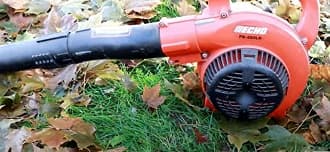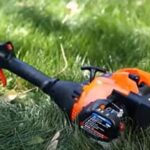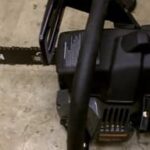As an Amazon Associate, this site earns commissions from qualifying purchases. For more information click here.
It can be frustrating if your Echo leaf blower has no spark and refuses to start. Before taking the tool to a repair center, check out the troubleshooting guide. Chances are the solution to your problem is right here.
If your Echo leaf blower has no spark, it is probably due to a defective spark plug. If tests show there is no spark, replace it with a new one. A clogged fuel filter or damaged primer bulb are common causes as well.
Before attempting any fix, make sure to go through the owner’s manual. Follow all the safety precautions for using a leaf blower to avoid accidents.
Damaged Ignition Coil
The ignition coil transmits voltage to the spark plug, allowing it to engage the engine. Because it works closely with the spark plug, you should check both if the engine refuses to start.
Solution. The first step is to check if the spark plug is functioning. Use a spark plug tester to verify this. Replace the plug if it is damaged. If the spark plug is fine, use an ignition coil tester. Replace the coil if it fails the test.
Clogged Fuel Vent
The fuel vent ensures air gets into the fuel reservoir so the engine runs properly. If your leaf blower starts and stalls, the vent is likely clogged up.
You can confirm this by taking off the fuel cap. As soon as you do the leaf blower starts running because it has access to air. If this is what happens, it is proof that the vent is faulty and no longer usable. This cannot be fixed and has to be replaced.
Solution. Check the fuel line as the vent is connected to it. Put the new fuel vent and the leaf blower should work now. This process is the same whether you are using the Echo X Series
A Non-Working Spark Plug
A faulty spark plug is the number one cause of Echo leaf blowers with no spark. Spark plugs get worn out over time. Signs of wear and tear are carbon deposits, burnt electrodes and cracks.
Solution. Refer to your owner’s manual to find the spark plug. If it has any of the signs listed above, replace it.
If the spark plug looks clean, run a spark plug tester. If there is no spark, the spark plug is defective and needs replacement. If there is a spark, the problem lies elsewhere. Check the rest of this guide for other possible solutions.
Malfunctioning Carburetor
The carburetor takes care of the fuel to air mix in the engine. If old fuel is left in the tank, it will eventually turn into a sludge. This substance clogs the carburetor and prevents it from working. If the carburetor is faulty there will be no spark to start the engine.
Solution. Cleaning the carburetor usually works. Turn the leaf blower off and remove the air filter casing to access it.
Use a carburetor cleaner to remove old fuel and dirt. Clean the fuel tank and remove whatever fuel is left. Pour fresh fuel and put the air filter casing back on.
Restart the leaf blower to see if it runs. If not, you can either rebuild the carburetor or buy a new one. If you are handy with mechanical stuff, rebuilding is an option. If you are not, you can buy a new carburetor, just make sure it is compatible with your Echo leaf blower. The Hipa PB250 Carburetor for example, is designed for the Echo PB250LN PB-250 ES250.
Blocked Fuel Filter and Fuel Lines
The fuel filter screens debris so nothing pollutes the fuel reservoir. This filter however, accumulates dirt and ends up clogged. A plugged fuel filter prevents fuel from getting into the engine. Without it there is no way for a leaf blower to start.
Solution. Replace the fuel filter with a new one. Most of these filters are for one-time use only anyway. To replace the fuel filter:
- Clean the fuel cap.
- Open the fuel tank cap. You will find the filter inside.
- Bend a small wire and use it to grab the fuel line and lift the filter out.
- With a pair of pliers, hold the fuel line and take out the filter.
- Install the new fuel filter.
A 2-stroke Echo leaf blower requires a 50:1 mix of gas and oil. This is equal to 2/6 fl oz of oil and a gallon of gas. Use only unleaded gasoline with no more than 10% ethanol. The octane rating should be 87-89.
Once you have added the right fuel, replace it every four weeks or sooner. This will prevent the fuel from turning gummy and clogging the engine.
A fuel stabilizer like Sea Foam Treatment is an effective way to keep fuel fresh and clean. If the fuel does not have any ethanol, a fuel stabilizer is not required.
Broken Primer Bulb
The primer bulb transmits the fuel to the carburetor so it can be mixed with air. If the primer bulb is damaged it won’t be able to perform this task. This can happen if the leaf blower is worn out or used in incorrect ways, such as drying a dog.
Solution. A damaged primer bulb has to be replaced. Go to the official Echo website and look for a primer bulb that works with your leaf blower model.
When you have the new bulb, refer to your owner’s manual on how to remove the old one. This will vary from one model to another.
Flooded Blower Engine
A flooded engine is a common problem with leaf blowers, and Echo models are not exempted. Fortunately the causes are well known and the fixes are straightforward.
The most common reasons for a flooded Echo leaf blower engine are:
- Too much fuel
- Damaged primer bulb
- Defective starter pulley
Solution. How you fix a flooded leaf blower engine depends on the cause.
Too much fuel. If there is too much fuel (you will be able to tell by the smell), just let the engine run. It will eventually burn out the excess fuel. When it does, turn the leaf blower and let the engine cool down. Turn it on again and see if the engine runs.
Damaged primer bulb. Replace the primer bulb with a new one.
Starter rope pulled too much or choke is in closed position. For these two cases, follow these steps.
- Move the Echo switch to run.
- Adjust the choke control so it is the run position.
- Pull the starter cord repeatedly while pressing the throttle. You might need to do this 6 to 16 times. Sometimes it might take more. Just keep doing it until the engine catches on.

Spark Arrestor Not Working
The spark arrestor has a pretty self-descriptive name. Its purpose is to arrest sparks that could ignite a fire. It is a screen that functions like a safety filter in leaf blowers.
Spark arrestors do a good job in preventing sparks, but it also gets clogged with engine soot. When that happens the device may not function properly and prevent the leaf blower from working.
Solution. Just like other engine parts, a spark arrestor may be cleaned or replaced. If the one on your leaf blower is reusable, clean it with a brush. If it is very dirty and no longer working, replace it.
Broken Recoil Starter
Echo leaf blowers depend on a recoil starter to get the engine going. When you use the recoil starter, it interacts with the crankshaft to rev the engine. If the recoil starter is not working, it will affect the rest of the engine.
Solution. Turn the leaf blower off and take out the starter assembly. Check your owner’s manual for details on how to do this as it can vary from model to model.
Pull the starter cord. The cam and pulley tabs should extend and take hold of the engine. This action activates the engine. When you let the rope go, the tabs should pull back.
That is how a recoil starter is supposed to work. If it does not, the assembly is damaged and has to be replaced.

I love the outdoors and all the tools for maintaining gardens, yards and lawns. The only thing I am more passionate about is sharing what I know about garden and outdoor equipment.


